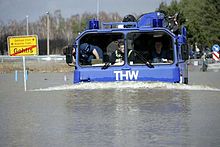Fording depth
Wading depth refers to the maximum water depth through which a land vehicle can drive (wade). The term appears frequently in the technical specifications of all-terrain vehicles, especially military vehicles.
Fording depth

The wading depth depends on many factors, including:
- Air intake height of the engine
- Height of the alternator and the ignition on the engine as well as the water resistance of the electrics / electronics
- Height of the unit ventilation of the vehicle ( axles , gearboxes , etc.)
- Sealing of the vehicle (interior) etc.
Depending on these points, cars can usually drive through bodies of water around 400 mm deep. Off-road vehicles can often be equipped for greater depths, especially if they are equipped with a snorkel that raises the air intake to the height of the vehicle roof. Water entering through the exhaust can also cause damage. For this reason, vehicles specially designed for fording are also equipped with a raised exhaust. Check valves are also used.
Wading through bodies of water
Places where water can be crossed, will ford called. While people, beasts of burden and wagons used to wade through fords, motorized vehicles can do so today. Even with sufficient fording ability, crossing water is often risky. The same problems occur as before , both in open terrain and at designated fords and on flooded paths:
- In addition to a maximum depth to be explored, the nature of the subsoil is unknown and can only rarely be fully assessed. The vehicle can sink in or unrecognized obstacles and bumps can lead to collisions and getting stuck.
- The flow can wash away vehicles or relocate in areas where they are no longer maneuver or where the fording depth is exceeded even at low speeds and low water depths.
- The buoyancy reduces the grip and thus the traction .
- Flotsam is another source of danger.
Deep wading and underwater driving

Military vehicles often have a fording depth of 0.5 to 1.5 meters. Some non-buoyant tank models that can be equipped with snorkels are also able to navigate deeper waters where the vehicle disappears partially or completely under the water surface. This is then referred to as deep wading or underwater driving at greater depths and requires preparation and e.g. T. additional equipment up to diving rescuers for the crew.
Battle tanks such as the Leopard 2 or the Marder infantry fighting vehicle have so-called diving hydraulics for driving through waters with a depth of around 2 to 4 m . It closes all ventilation on the engine and opens a combustion air flap on the engine bulkhead inside the tank (fighting compartment). During wading, deep wading and underwater driving, the engine draws in the combustion air through the commander's hatch with the deep-water or underwater shaft (Leopard 2) attached. The tower is sealed to the tub by an inflatable seal. Bilge pumps transport penetrating water to the outside.
During the Second World War, diving tanks were developed on the German side (including conversions of 168 PzKpfw III and 42 PzKpfw IV ) that were able to travel in water depths of up to 15 m. The air was supplied via a hose that was attached to a buoy. They were originally supposed to be released off the coast of ships for the invasion of England and then navigated by means of observers on the ships, radio communication and compass. On June 22, 1941, the first day of the Russian campaign, 80 of these submersible tanks were used. They all successfully crossed the Bug River .


